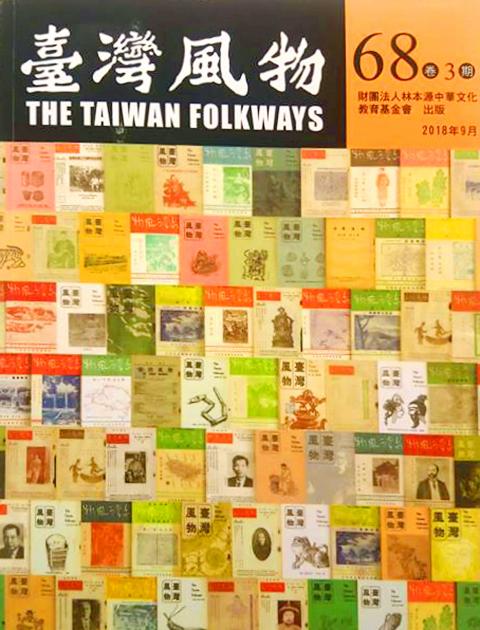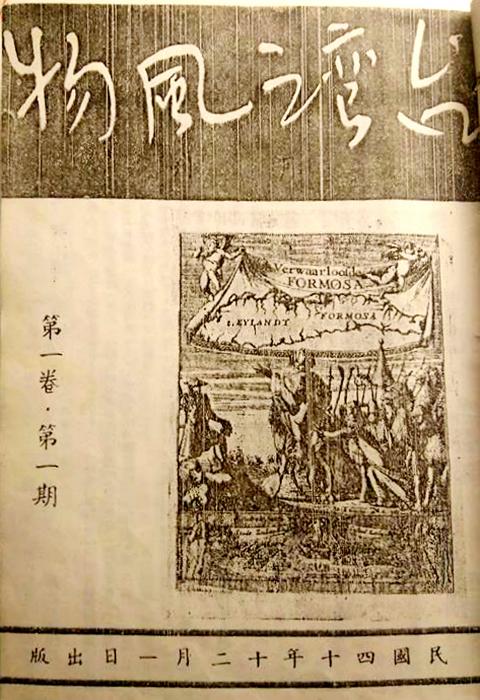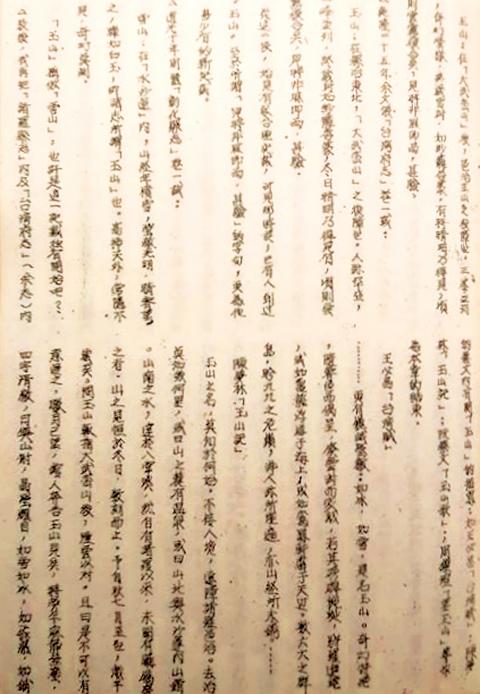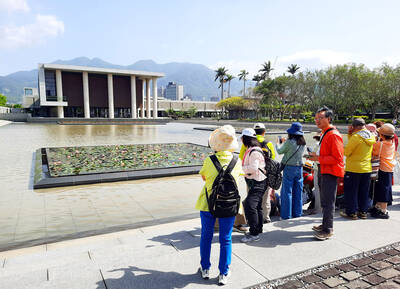Dec. 31 to Jan. 6
Devoted to a topic that the ruling government disapproved of, The Taiwan Folkways (台灣風物) struggled mightily in its early years. At one point, it was under such financial pressure that one issue simply contained handwritten manuscripts.
Former editor-in-chief and former Academia Historica president Chang Yen-hsien (張炎憲) writes that in the beginning of Chinese Nationalist Party (KMT) rule, Taiwanese intellectuals were eager to debate politics and discuss the uniqueness of Taiwanese culture. But such topics became taboo during the White Terror era. The government wanted people to identify with China and Chinese culture, and there was no official place for Taiwanese studies.

Photo courtesy of National Central Library
“Taiwanese culture was excluded from the education system … and scholars who were interested in the topic were unable to pursue it. Those who were interested in the field were left to fend for themselves by submitting amateur articles to independent publications,” Chang writes on the 60th anniversary of the founding of The Taiwan Folkways.
The publication debuted on Dec. 31, 1951, with 1956 to 1960 its toughest years. Stability finally arrived as Lin Chung-chih (林崇智) of the wealthy Banciao Lin Family became involved in 1966. It still survives today, making it the longest-running non-governmental publication in Taiwan.
JAPANESE PREDECESSOR

Photo courtesy of National Central Library
The Taiwan Folkways was heavily influenced by Minzoku Taiwan, a Japanese-language publication that, curiously, debuted in July 1941 when the colonial government’s Kominka Movement (皇民化運動), an effort to shift Taiwanese culture closer to that of Japan, was in full swing. The founder and publisher was Toshio Ikeda, who moved to Taiwan when he was seven years old, but he used various pen names due to his position with the Taiwan Governor-General Office’s information department. He partnered with Takeo Kanaseki, a prominent anthropologist, who used his reputation to serve “as a shield against government interference,” states the Catalogue of Taiwan Literature Journals Web site.
The publication ran for 43 editions until February 1945, covering topics ranging from daily customs to Hoklo (also known as Taiwanese) idioms to games, festivities, divination methods and medicine. It contained iconic illustrations and woodblock prints by Tetsuomi Tateishi, a Taiwan-born Japanese painter who contributed to numerous Taiwanese publications starting from 1935.
According to the Catalogue of Taiwan Literature Journals, The Taiwan Folkways closely mimicked Minzoku Taiwan’s editorial style, cover design, illustration style and the two were similar even in the number of pages. Many contributors to Minzoku Taiwan continued writing in The Taiwan Folkways, making it somewhat of a continuation of its colonial predecessor.

Photo courtesy of Wikimedia Commons
After World War II, the KMT established the Taiwan Provincial Editorial and Translation Bureau (台灣省編譯館) to continue the Japanese efforts on Taiwan studies — but the bureau lasted for less than a year, abolished shortly after the 228 Incident, an anti-government uprising and subsequent brutal crackdown. Much of its material was never published. After 228, the KMT established the Taiwan Historica (國史館臺灣文獻館) which focused on Taiwanese history. Historian Hsieh Hsueh-chi (謝雪姬) writes that the purpose was to pacify and assign a sense of purpose to the Taiwanese intellectuals who survived the incident. The bureau’s Taiwan Historica was the government’s only publication devoted to Taiwanese cultural studies.
The government’s efforts were obviously unsatisfactory, as The Taiwan Folkways criticized them in its second anniversary issue: “As early as 1944, the central government included ‘surveying Taiwan’s culture and customs’ in its plans for taking over Taiwan … Eight years have passed, and not only has the investigation of Taiwan’s folk culture not commenced, it’s not even taken seriously!”
ALL ABOUT TAIWAN

Photo courtesy of National Central Library
The Taiwan Folkways likely benefited from not being founded by a Taiwanese, but by Chen Han-kuang (陳漢光), a retired KMT military captain from China’s Fujian Province. Hsieh writes that whenever the government had a problem with the publication, Chen was able to use his status and connections to resolve the issue.
Chen’s editor-in-chief was Yang Yun-ping (楊雲萍), a literature scholar-turned-historian who was involved in both Minzoku Taiwan and the Taiwan Provincial Editorial and Translation Bureau. The Ministry of Culture’s Encyclopedia of Taiwan states that as a National Taiwan University professor, he was the first to teach a class solely devoted to Taiwanese history.
Chen’s first recorded publication was the 1948 History of Taiwanese Resistance Against the Japanese (台灣抗日史). In its preface, Yang wrote, “It’s hard to find a country in the world with a history as fascinating and complicated as Taiwan’s, but there are just too few publications and researchers. [Chen] can be seen as the post-war pioneer of the field of Taiwanese history.”
The inaugural issue of The Taiwan Folkways featured on the cover Neglected Formosa, a book by the last Dutch governor, Frederick Coyett, about how the Dutch colonizers were expelled from Taiwan by Ming Dynasty loyalist Koxinga (鄭成功). In the call for submissions, it stated: “This publication is devoted to writings about Taiwan’s history, geography, arts, folk culture, religion and so on. We also welcome articles about [China] that directly or indirectly relate to Taiwan.”
The articles in the first issue include “Discussing the parameters of Taiwan’s prehistory,” “Earthquakes during the Dutch colonial era,” “Legends from Shilin,” “Taiwan folktales,” an etymology of the words for “man” and “woman” in Hoklo and an introduction to the music played at Tainan’s Confucius Temple.
The editors had to tread carefully to keep anything that would potentially offend the government from making it into the publication. Nevertheless, it was suspended once for two months, and Hsieh writes that it was forced to include a poetry supplement celebrating then-president Chiang Kai-shek’s (蔣介石) 66th birthday. She postulates that this led to Yang’s departure after that issue was published on Dec. 1, 1952.
Chen soldiered on, somehow keeping the publication afloat for 14 more years until Lin came aboard.
Taiwan in Time, a column about Taiwan’s history that is published every Sunday, spotlights important or interesting events around the nation that have anniversaries this week.

When the South Vietnamese capital of Saigon fell to the North Vietnamese forces 50 years ago this week, it prompted a mass exodus of some 2 million people — hundreds of thousands fleeing perilously on small boats across open water to escape the communist regime. Many ultimately settled in Southern California’s Orange County in an area now known as “Little Saigon,” not far from Marine Corps Base Camp Pendleton, where the first refugees were airlifted upon reaching the US. The diaspora now also has significant populations in Virginia, Texas and Washington state, as well as in countries including France and Australia.

On April 17, Chinese Nationalist Party (KMT) Chairman Eric Chu (朱立倫) launched a bold campaign to revive and revitalize the KMT base by calling for an impromptu rally at the Taipei prosecutor’s offices to protest recent arrests of KMT recall campaigners over allegations of forgery and fraud involving signatures of dead voters. The protest had no time to apply for permits and was illegal, but that played into the sense of opposition grievance at alleged weaponization of the judiciary by the Democratic Progressive Party (DPP) to “annihilate” the opposition parties. Blamed for faltering recall campaigns and faced with a KMT chair

Article 2 of the Additional Articles of the Constitution of the Republic of China (中華民國憲法增修條文) stipulates that upon a vote of no confidence in the premier, the president can dissolve the legislature within 10 days. If the legislature is dissolved, a new legislative election must be held within 60 days, and the legislators’ terms will then be reckoned from that election. Two weeks ago Taipei Mayor Chiang Wan-an (蔣萬安) of the Chinese Nationalist Party (KMT) proposed that the legislature hold a vote of no confidence in the premier and dare the president to dissolve the legislature. The legislature is currently controlled

Dull functional structures dominate Taiwan’s cityscapes. But that’s slowly changing, thanks to talented architects and patrons with deep pockets. Since the start of the 21st century, the country has gained several alluring landmark buildings, including the two described below. NUNG CHAN MONASTERY Dharma Drum Mountain (法鼓山, DDM) is one of Taiwan’s most prominent religious organizations. Under the leadership of Buddhist Master Sheng Yen (聖嚴), who died in 2009, it developed into an international Buddhist foundation active in the spiritual, cultural and educational spheres. Since 2005, DDM’s principal base has been its sprawling hillside complex in New Taipei City’s Jinshan District (金山). But